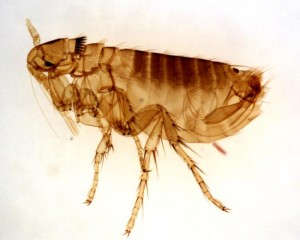May 11, 2012 | Pest Control
How can something as small as a flea be such a huge pain? Pet owners are all too familiar with the annoyance of fleas because they make us AND our pets miserable. Fleas attach themselves to warm-blooded animals (pets and humans) and feed on their blood. A flea bite can cause discomfort, painful, itchy red bumps and can lead to an allergic reaction. In some cases, they can even transmit diseases like the bubonic plague, murine typhus and transfer tapeworms in pets.

To prevent fleas from becoming a pest in your home, clean and vacuum frequently. A clean home is a healthy home and will aid in the prevention of other pests as well. Cleaning will help to remove any fleas and their eggs. Maintaining a clean yard is just as important, especially if you have pets that go outside often. A well kept lawn with no debris or pet droppings will reduce the flea population around your home. Bathe pets regularly and apply a flea and tick treatment. Most importantly, call a professional exterminator if you have fleas in your home. A flea infestation can be very difficult to get rid of and is best left to the professionals so the problem does not continue to grow.
Interesting Flea Facts:
- The largest recorded flea measured almost ½ inch!
- Fleas consume 15 times their weight in blood each day. That is like a 140 lb. woman eating 8,400 burgers in one day!
- Fleas are the number one cause of allergies in cats and dogs.
- Fleas can live for about 100 days.
- Fleas don’t fly, they jump.
- A pair of fleas can produce 400-500 offspring in their lifetime.
- A flea can jump up to 8 inches high or 150 times its own height.
Got a flea problem? Call Northwest Exterminating for professional, effective flea control.
Feb 14, 2012 | Pest Control
Valentine’s Day is a day of LOVE! Bugs aren’t something that we usually “love” but in the spirit of the holiday, here are 5 bugs to love!

- Ladybugs are not only one of the cuter bugs out there but they are beneficial because they eat large quantities of aphids, mites and other arthropods that feed on various plants in your yard or garden. Imported more than 100 years ago to defend orchards and orange groves, ladybugs can eat up to 5,000 pests in their lifetime.
- Earthworms are nature’s most efficient composters. These scavengers create the kind of well-aerated, humus-rich soil gardeners call “black gold.”
- The love bug is also known as the honeymoon fly, kissing bug, or double-headed bug. The adult is a small, flying insect common to the southeastern United States, especially along the Gulf Coast. During and after mating, adult pairs remain coupled, even in flight, for up to several days.
- The praying mantis is named for the “praying” position that it often assumes. This insect will eat just about any living thing it can fit in its mouth, helpful or not. It is known to consume mosquitoes, nocturnal moths, bees, beetles, small lizards, even frogs—as well as fellow praying mantises.
- Bumblebees collect nectar and the pollen that will make tomato plants and apple trees produce more fruit. The female bumblebee can sting but they much prefer to stick to gentler business.